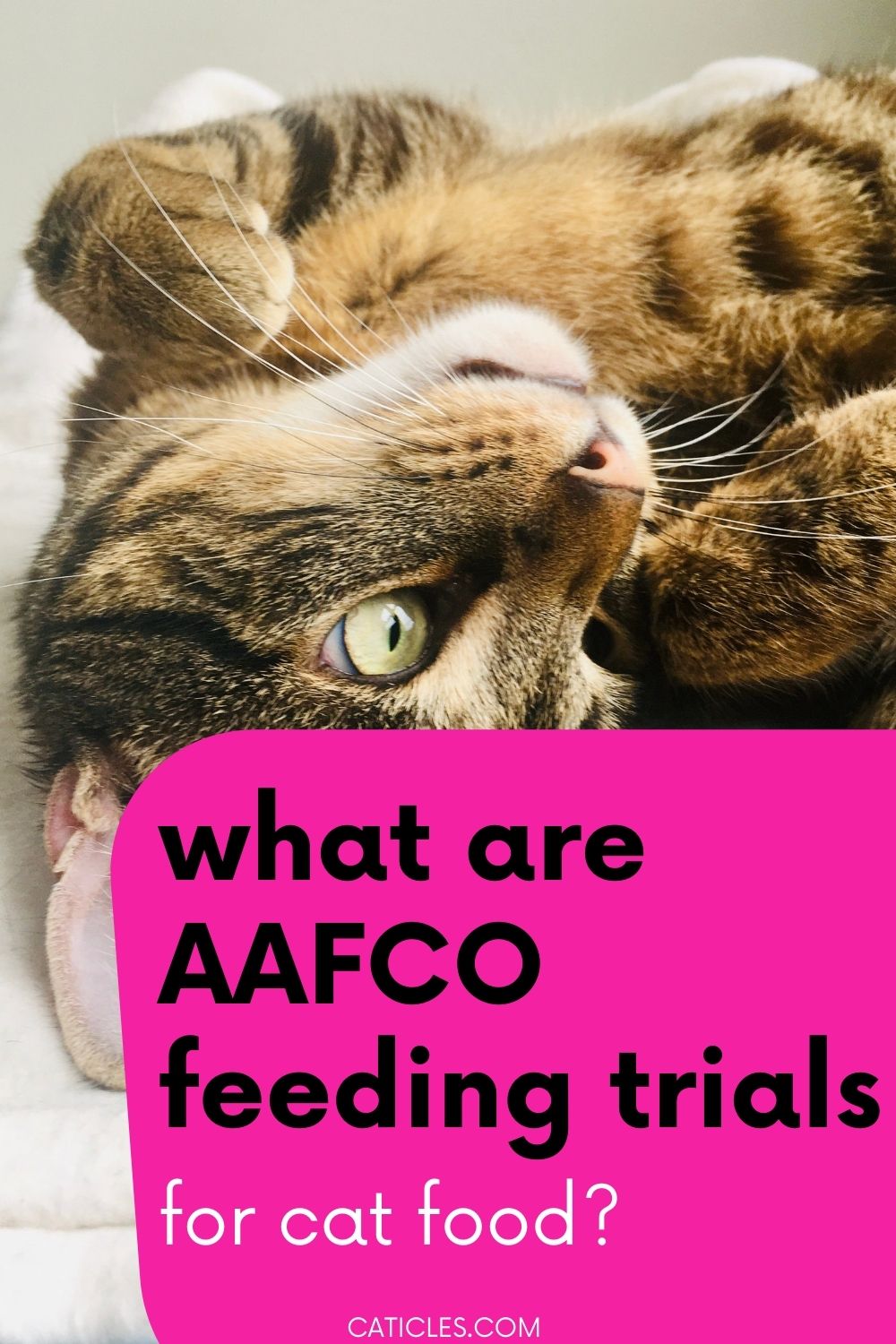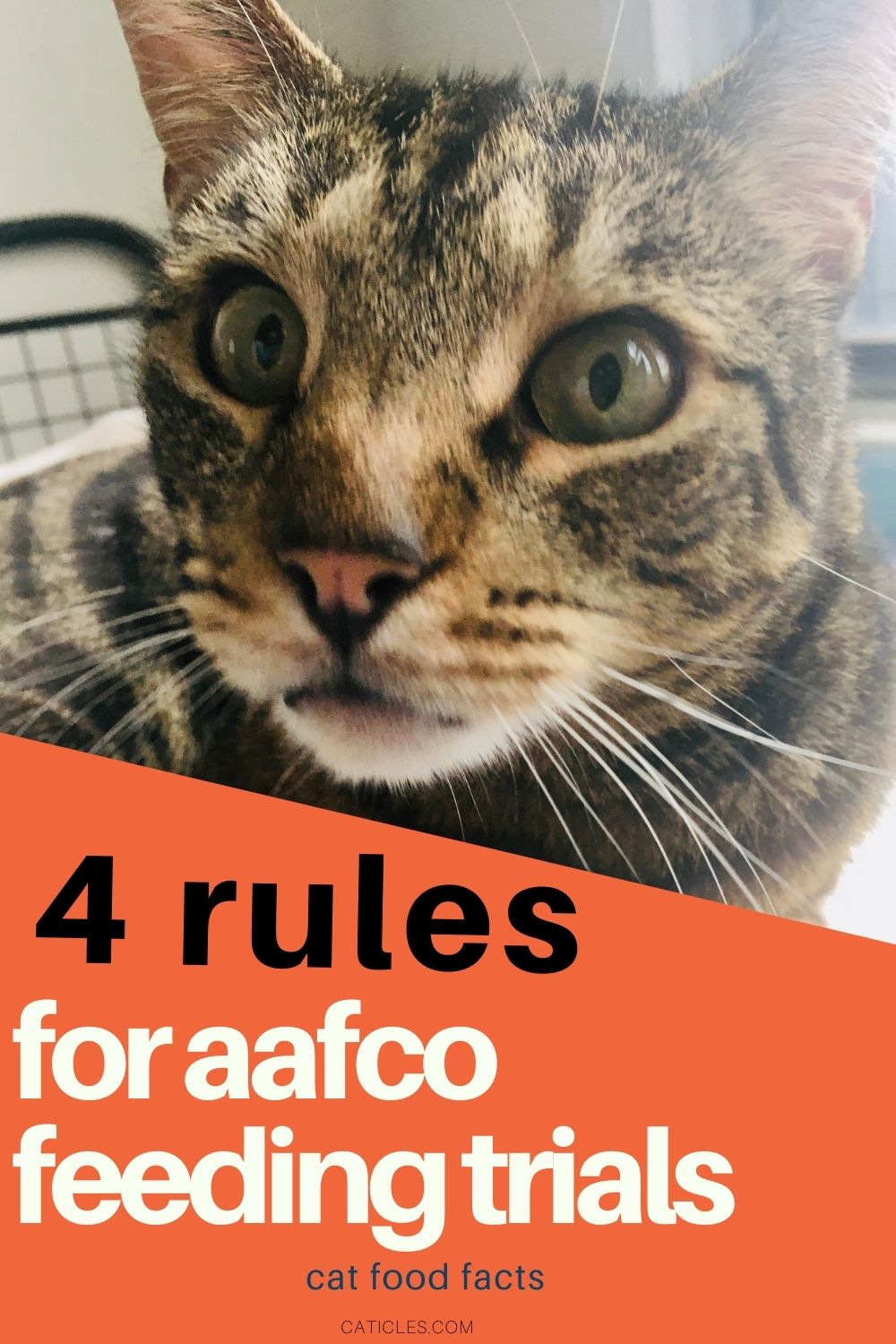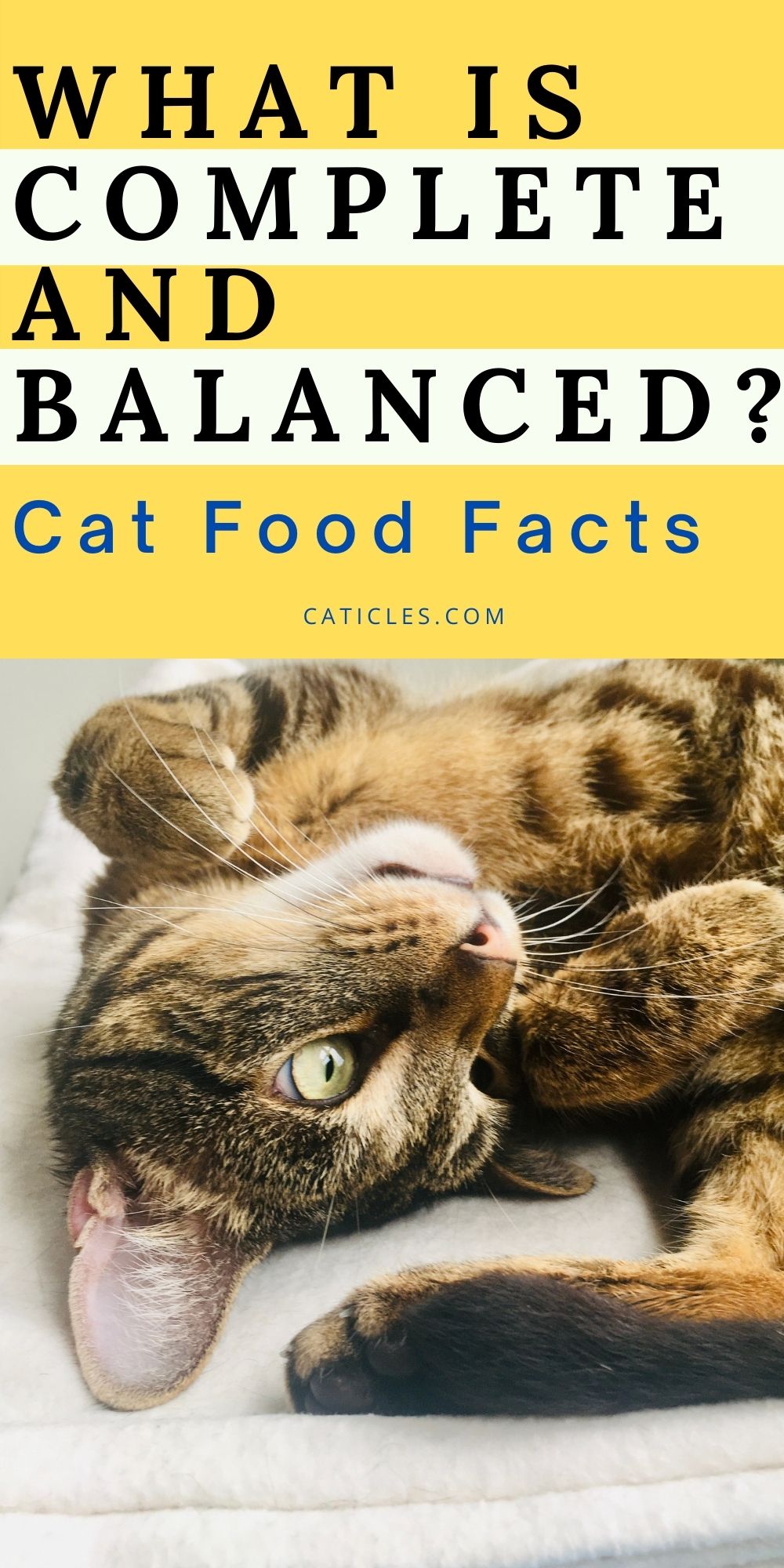AAFCO feeding trials for cat food are not that impressive.
Feeding trials only last 6 months, 25% of animals can drop out, and they do not consider weight gain, only weight loss.
AAFCO feeding trials do not require much in terms of blood tests.
They require only 4 blood parameters out of 40.
Here are the AAFCO feeding trials for cat food:
Note: AAFCO does not approve, test, certify, or endorse cat food.
They do not inspect or regulate the quality of cat food.
No one does.
AAFCO only sets standards and makes rules for pet food manufacturers to follow when labeling products.
Check out the guide today or pin the image below to your Cat Food board on Pinterest.

This post has affiliate links through which I earn a commission. No additional cost to you. Please read my disclaimer.
Also, nothing I say is medical advice.
Nutritional requirements
AAFCO nutritional requirements are based on the National Research Council (NRC).
The NRC charges a fee for their most recent book published in 2006, Nutrient Requirements of Dogs and Cats.
But the NRC also has a free PDF pamphlet Your Cat’s Nutritional Needs that summarizes exactly what the title states.
You’ll find information about the macronutrients protein, fat, and carbohydrate.
And average recommended daily energy, vitamin, and mineral requirements.
Protein
The pamphlet states, “As carnivorous animals, cats derive most of their protein from meat, fish, and other animal products…
Some animal-based protein is easier to digest than plant-based protein and is better suited to the cat’s digestive system.”
So right there we know that cats need nutrition from animal-based protein.
Plant-based protein is not suitable for cats.
However, most pet food manufacturers bulk up the protein amount by adding plant-based ingredients.
You’ll learn this reading through cat food label rules and ingredients in cat food .
Carbohydrate
“While not essential in the diet, carbohydrates provide an abundant source of energy.
The major sources of carbohydrates in commercial cat foods are cereals, legumes, and other plant foodstuffs…
Because cats are carnivores, the short length of their long intestines limits their ability to ferment fibers that are found in many carbohydrates.”
I’m glad that the NRC admits that carbohydrates are not essential to the cat’s diet.
However, stating that they are an “abundant source of energy” is not completely accurate.
Carbohydrates and starches break down into sugar. Excess sugar is stored as fat.
The cat’s natural diet consists of proteins and fats from animal sources.
So how can carbohydrates be suitable?
Also, sugar fuels obesity, related diseases, and certain cancers.
Fat
“Fats contain more than twice as much energy as protein and carbohydrates per gram.
Dietary fats supply essential fatty acids that cannot be synthesized in the body and serve as carriers for important fat-soluble vitamins…
Fatty acids play an important role in cell structure and function…
Studies indicate that cat foods containing even higher amounts of fat are safe. At a minimum, cat foods should have a fat content of about 9% of dry matter.”
Clearly, your cat should get its energy from animal-based protein and fat.
Not from carbohydrates.
I explain this because most commercial dry and wet cat foods that “meet AAFCO standards” average 25-50% carbohydrates.
We can confirm this with the guaranteed analysis and cat food label rules.
Most cat foods fit under the 25% “dinner” rule. Meaning, the minimum requirement for meat is only 25%.
Additionally, some “prescription” diets have no minimum requirement of meat.
Complete and balanced claims definitions
AAFCO lists some of the definitions on its website.
However, if you want the full AAFCO publication, you have to spend $150 (non-members price).
PS- This is problematic because this should be public information.
Don’t we deserve to know exactly what is in our cat’s food?
Why should we have to pay a large fee to read the full ingredient definitions?
AAFCO is supposed to be a non-profit organization.
Balanced
“A term that may be applied to a diet, ration, or feed having all known required nutrients in proper amount and proportion based upon recommendations of recognized authorities in the field of animal nutrition, such as the National Research Council, for a given set of physiological animal requirements. The species for which it is intended and the functions such as maintenance or maintenance plus production (growth, fetus, fat, milk, eggs, wool, feathers, or work) shall be specified.”
Complete feed
“A nutritionally adequate feed for animals other than man; by specific formula is compounded to be fed as the sole ration and is capable of maintaining life and or promoting production without any additional substance being consumed except water.”
Note: AAFCO sets standards for FEED law. But they refer to our cat’s food as food?
Label claims
Pet food manufacturers have 3 options when it comes to the “complete and balanced” claim on the product label.
- Product A is formulated to meet the nutritional levels established by the AAFCO Dog or Cat Nutrient Profiles for Life Stage B.
- Animal feeding tests using AAFCO procedures substantiate that Product A provides complete and balanced nutrition for Life Stage B.
- Product A provides complete and balanced nutrition for Life Stage B and is comparable in nutritional adequacy to a product which has been substantiated using AAFCO feeding tests.
Formulated
The first option, “formulated”, means that the product meets the nutritional requirements set by AAFCO.
Feeding tests
The second option, “animal feeding tests”, means that the product has passed AAFCO’s criteria for feeding trials.
Comparable
The third option, “comparable in nutritional adequacy”, means that the product’s nutrition is similar to another “family” product that has passed AAFCO’s criteria for feeding trials.
Remember, AAFCO does not certify or test cat food.
The organization makes rules and sets standards for manufacturers to follow.

AAFCO feeding protocol
The AAFCO feeding protocol for feeding trials is very loose.
- 6 out of 8 cats must pass
- 6-month duration
- 4 blood parameters tested at the end
- 15% or less weight loss allowed
The feeding trial starts with 8 young and healthy cats. 2 cats are allowed to drop out, for various reasons.
So manufacturers can still use the “complete and balanced” claim if 75% of the cats pass.
6 months duration is problematic. Most cat parents feed the same cat food for the cat’s entire life.
So basically, feeding trials are for 6-month maintenance. And your cats are the test subjects for lifetime maintenance.
Only 4 blood parameters are tested at the end of the feeding trial.
There are 40 parameters that Dr. Croger, a veterinarian nutritionist, tests on her dogs as baseline data.
Feeding trials monitor weight loss but not weight gain.
Going back to nutritional needs and carbohydrates…
Many commercial cat foods, especially kibble, are dangerously high in carbohydrates.
Carbohydrates lead to weight gain.
And overweight cats are at a higher risk for many diseases, health issues, and shorter lives.
But cats gain weight over time.
It is much more likely that your cat became overweight over the years. Not over 6 months.
Also, this about this…
If kibble companies didn’t think their products make cats gain weight, why would they spend millions on creating “weight loss diet” products?
How can 6 months of only 6 cats and 10% of blood parameter tests be accurate enough to feed a product to your cat for its entire life?
Another important thought…
Typically, younger and healthier cats are in feeding trials.
Dr. Elizabeth Hodgkins puts this into perspective perfectly in her book Your Cat: Simple New Secrets to a Longer Stronger Life.
Imagine that a fast-food joint conducted feeding trials for 6 months using teenagers.
Teens would likely pass the feeding trials because their metabolism is better than adults.
So now the fast-food joint can label their products as nutritionally-appropriate for lifetime feeding.
Does that make sense to you?
Final thoughts on AAFCO feeding trials
I’m not saying that you should disregard feeding trials and AAFCO nutritional requirements.
Cat nutrition is complex. We are learning more every day.
Instead, educate yourself.
Don’t rely on pet food manufacturers to decide for you.
At the end of the day, you (and only you) are responsible for your cat’s health.
- Learn cat food label rules. Even the FDA says do not be swayed by fancy gimmicks and marketing claims on the label.
- Kibble is bad for cats. Cats cannot survive and thrive on dry food only.
- Find a high-protein, low-carb wet cat food. This is much more suitable for cats than kibble.
- Transition cat food slowly. Any new food needs a proper transition or you’ll make your cat sick.
- Study BARF diets for cats. Holistic veterinarian nutritionists agree that balanced raw diets are the most appropriate and natural food for cats.
Cats need meat to survive and thrive.
Need help feeding your picky cat better? My switch your cat to raw course is for you!
Related articles to cat food:
- AAFCO Approved Cat Food Brands Don’t Exist! Here’s Why
- 5 Reasons Your Vet Recommended Cat Food is Complete Garbage
- Worst Cat Food Brands to Avoid Based on AAFCO Food Label Rules
- Cat Weight Loss Program for Your Cat that Won’t Lose Weight

